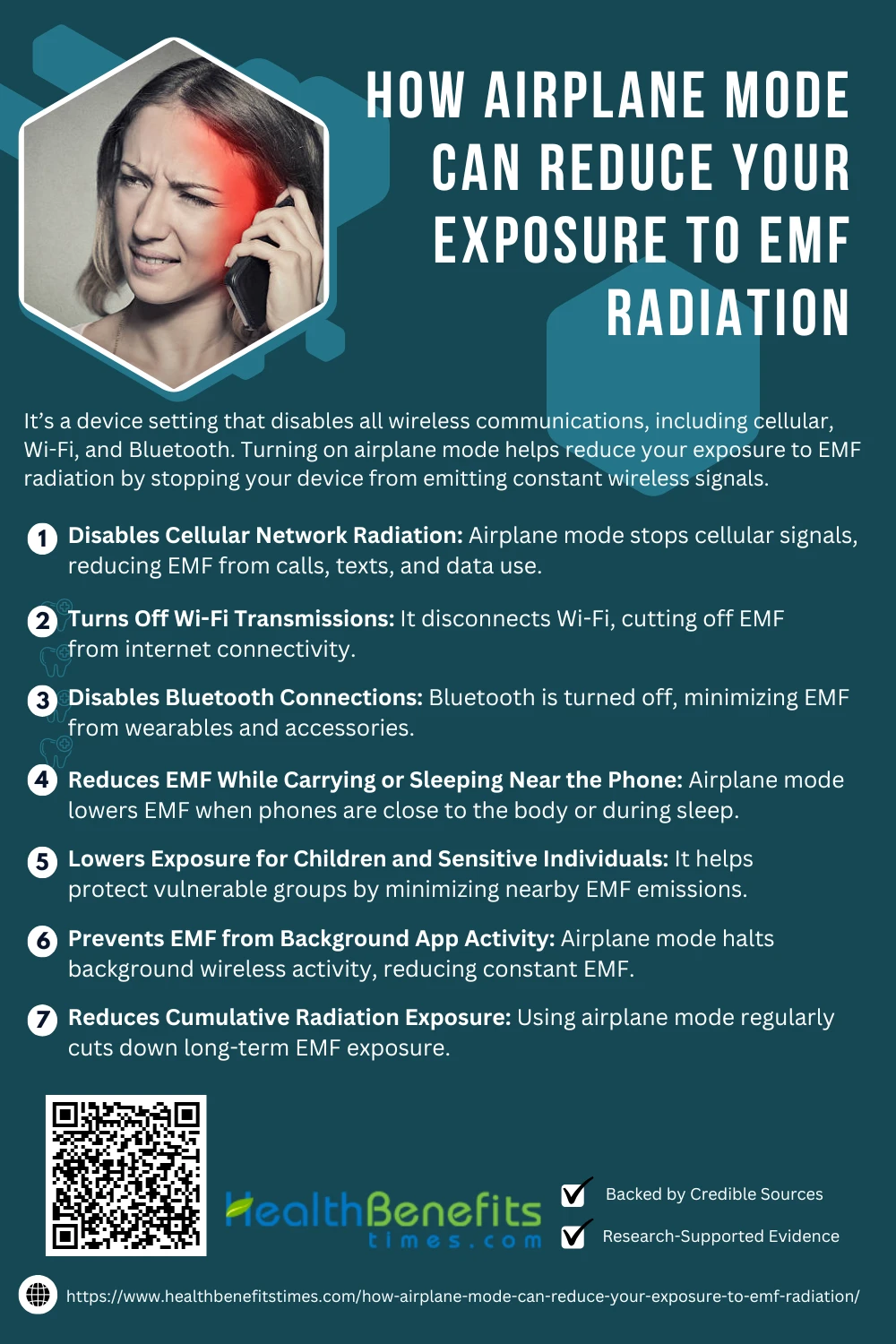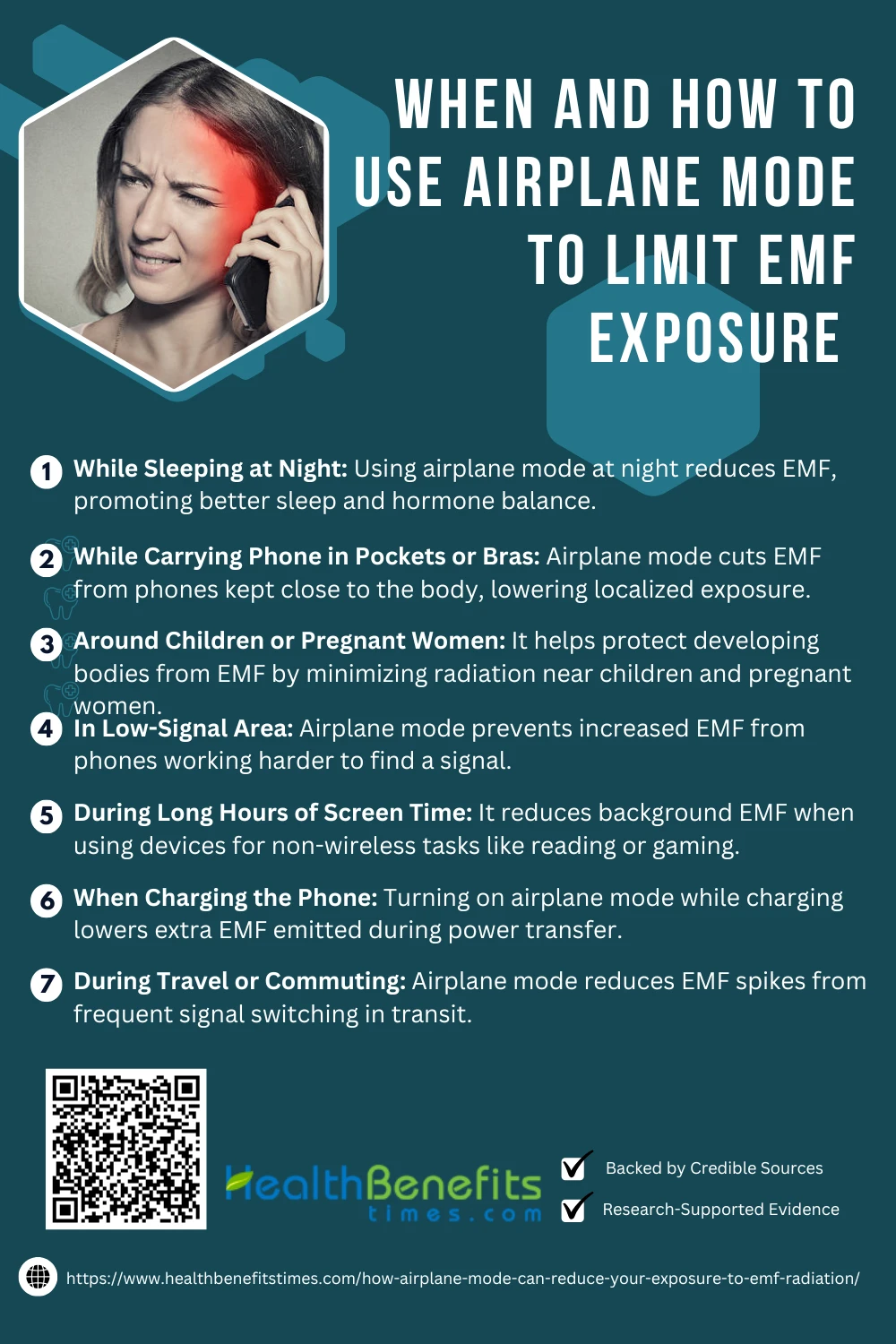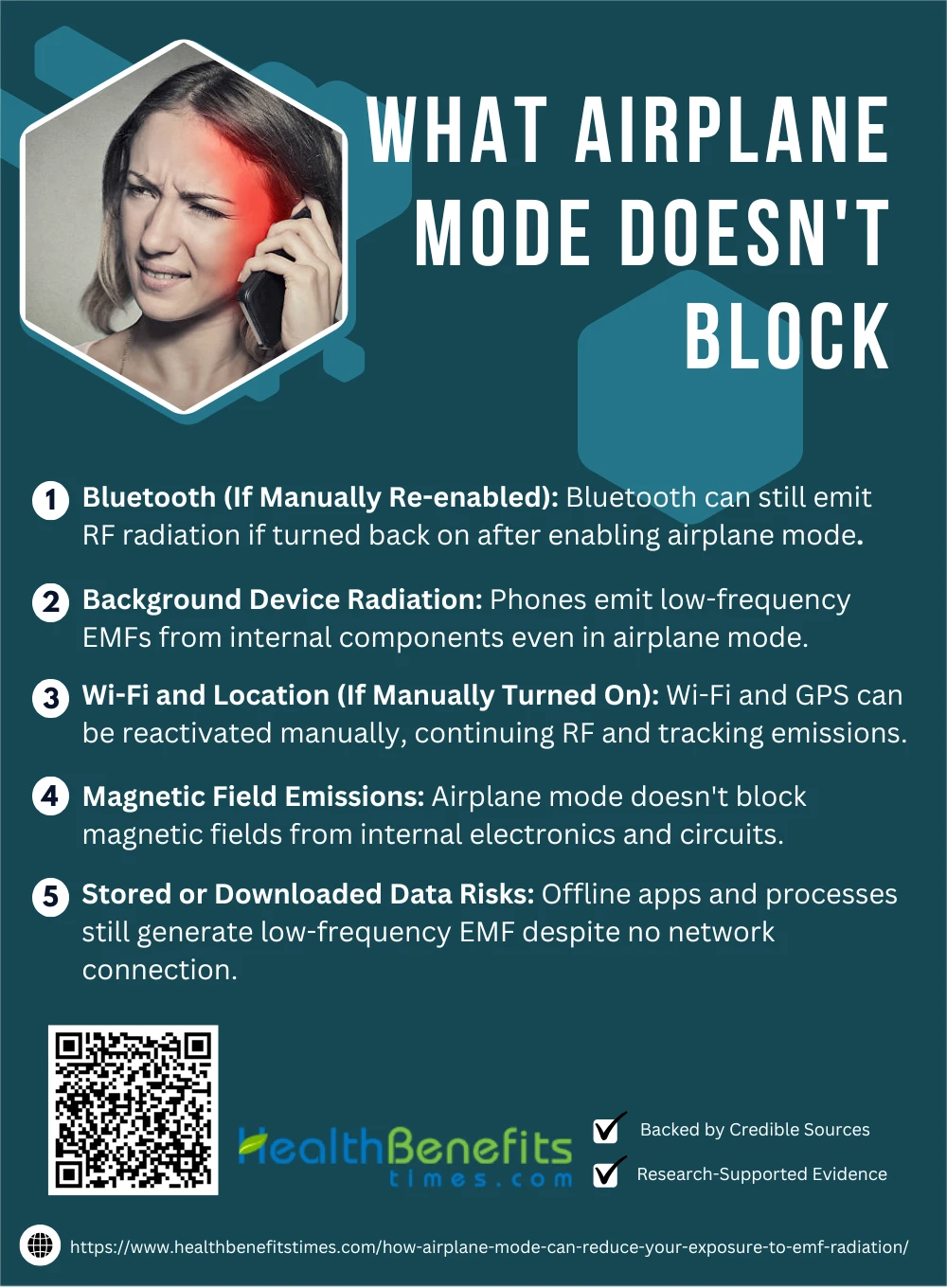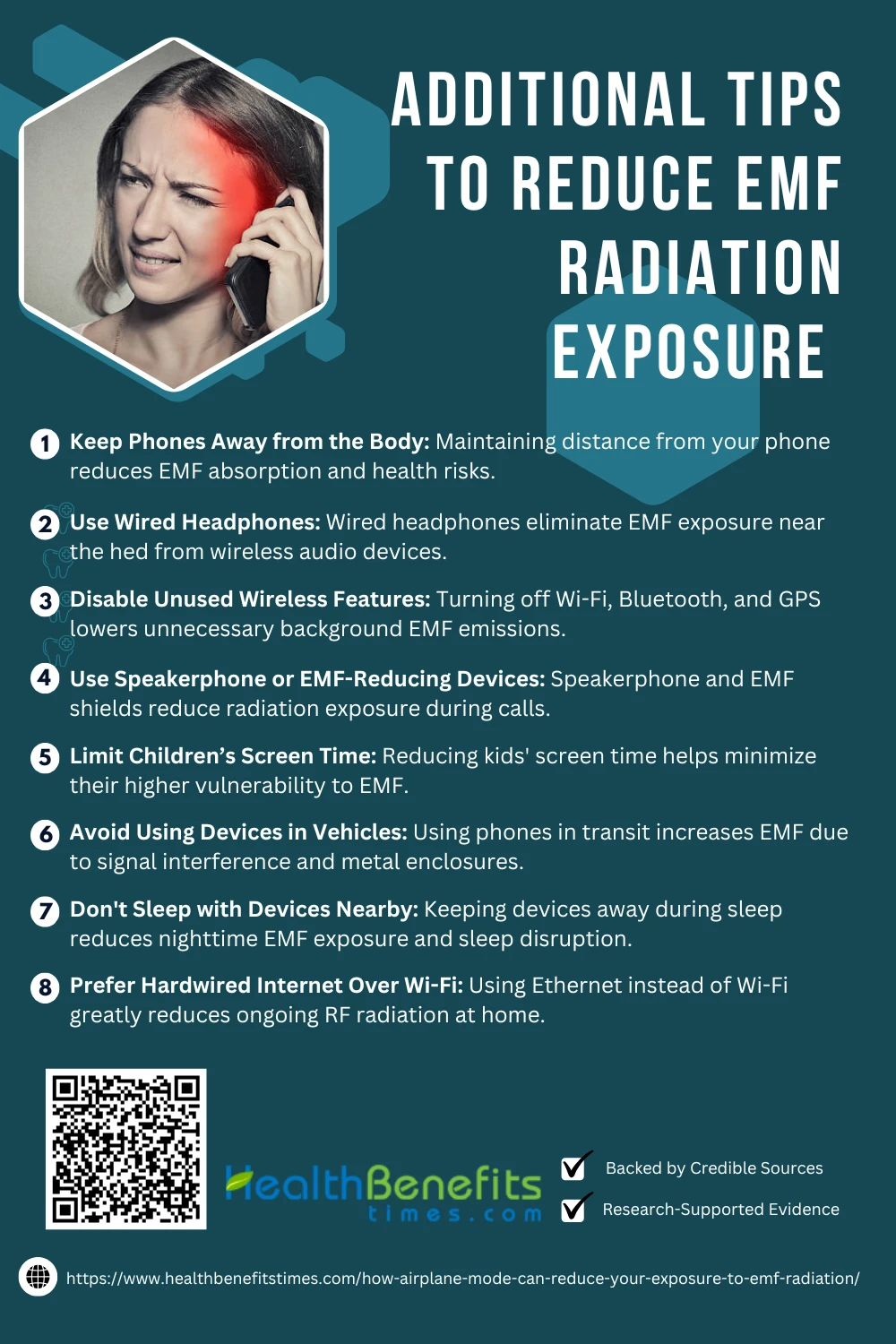- It’s a device setting that disables all wireless communications, including cellular, Wi-Fi, and Bluetooth.
- Turning on airplane mode helps reduce your exposure to EMF radiation by stopping your device from emitting constant wireless signals.
- Using it during sleep or when carrying your phone close to your body is a simple way to minimize potential health risks.
 Airplane Mode is a setting on mobile devices that disables wireless communication functions such as cellular, Wi-Fi, and Bluetooth signals, as explained by the Federal Communications Commission. With increasing awareness around electromagnetic field (EMF) exposure from smartphones and connected devices, many users are exploring simple methods to reduce potential health risks. One effective strategy is enabling airplane mode, which significantly lowers a device’s emission of radiofrequency (RF) radiation. According to the Environmental Health Trust, mobile devices actively transmit EMF when connected to cellular networks, Wi-Fi, or Bluetooth. Switching to airplane mode disables these transmissions, reducing close-range exposure, especially during sleep or when devices are in direct contact with the body. The BioInitiative Report also recommends minimizing unnecessary EMF exposure as a precautionary approach, especially for children and sensitive individuals.
Airplane Mode is a setting on mobile devices that disables wireless communication functions such as cellular, Wi-Fi, and Bluetooth signals, as explained by the Federal Communications Commission. With increasing awareness around electromagnetic field (EMF) exposure from smartphones and connected devices, many users are exploring simple methods to reduce potential health risks. One effective strategy is enabling airplane mode, which significantly lowers a device’s emission of radiofrequency (RF) radiation. According to the Environmental Health Trust, mobile devices actively transmit EMF when connected to cellular networks, Wi-Fi, or Bluetooth. Switching to airplane mode disables these transmissions, reducing close-range exposure, especially during sleep or when devices are in direct contact with the body. The BioInitiative Report also recommends minimizing unnecessary EMF exposure as a precautionary approach, especially for children and sensitive individuals.
What is EMF Radiation?
Electromagnetic field (EMF) radiation is a form of energy emitted by electrically charged objects, broadly categorized into non-ionizing (e.g., radiofrequency, extremely low frequency) and ionizing radiation (e.g., X-rays) as defined by the World Health Organization. (1) Common household EMF sources include mobile phones, Wi-Fi routers, baby monitors, and microwave ovens, according to the CDC. (2) Long-term exposure may pose potential health risks, including cancer and neurological effects, as suggested by National Cancer Institute.
What is Airplane Mode?
Airplane mode is a built-in feature on mobile devices that suspends the device’s ability to send or receive wireless communication, primarily to comply with in-flight safety regulations, as noted by the Federal Communications Commission (FCC). When activated, airplane mode disables cellular, Wi-Fi, Bluetooth, and GPS services, reducing signal emissions, according to Harvard University IT. (3) Originally designed to prevent electromagnetic interference with aircraft systems, its broader use now includes reducing distractions and EMF exposure, especially in daily life.
How Airplane Mode Reduces EMF Exposure
Airplane mode helps reduce EMF exposure by disabling wireless signals like cellular, Wi-Fi, and Bluetooth, stopping your device from emitting constant radiofrequency radiation, especially during periods of inactivity.
1. Disables Cellular Network Radiation
Activating airplane mode on a mobile device disables its cellular connection, effectively halting radiofrequency (RF) radiation emitted during voice calls, texting, and data transfer, as explained by the Federal Communications Commission. This reduces exposure to EMFs generated when phones connect to towers, particularly in weak signal areas, according to the Environmental Health Trust. The BioInitiative Report and National Cancer Institute both highlight risks of prolonged RF exposure. Studies by Harvard School of Public Health further support using airplane mode as a preventive health measure. (4)
2. Turns Off Wi-Fi Transmissions
When airplane mode is activated, the device disconnects from Wi-Fi networks, preventing transmission of electromagnetic signals used for internet connectivity. This significantly reduces RF radiation, especially when the device is idle or placed near the body, as noted by the FCC and Environmental Health Trust. Research from the Bio Initiative Report and NIH confirms Wi-Fi contributes to EMF exposure. (5) Harvard IT recommends using airplane mode to minimize ambient radiation indoors. (3)
3. Disables Bluetooth Connections
Airplane mode typically disables Bluetooth functionality, halting short-range radiofrequency communication between devices. This is important because Bluetooth emits continuous low-level RF signals even when idle, according to the Federal Communications Commission. Disabling it reduces total EMF exposure from wearables and wireless accessories, as shown in NIH studies. (6) The Environmental Health Trust and BioInitiative Report also recommend minimizing Bluetooth use. (7) University of California Health suggests airplane mode as a preventative approach.
4. Reduces EMF While Carrying or Sleeping Near the Phone
Activating airplane mode significantly reduces exposure to electromagnetic fields (EMF), particularly during sleep or close body contact. Studies show phones emit radiofrequency radiation even in idle mode. (8) Placing devices in airplane mode halts most emissions, including RF-EMF from cellular and Wi-Fi signals. (9) Night-time exposure has been associated with melatonin suppression and sleep disturbances. (10) (11) Hence, minimizing EMF through airplane mode is a precautionary measure supported by EMF risk literature. (1)
5. Lowers Exposure for Children and Sensitive Individuals
Children and sensitive populations are especially vulnerable to EMF due to developing biological systems. (12) Research confirms that airplane mode disables most EMF-emitting functions, reducing exposure from proximity-based use like pockets or bedsides. Lowering RF exposure may help reduce oxidative stress in children and mitigate behavioral impacts. (13) (14) Experts suggest EMF safety thresholds may be too high for children, and minimizing EMF is recommended in precautionary guidelines. (15) (16)
6. Prevents EMF from Background App Activity
Even when idle, smartphones engage in background activity—syncing data, fetching updates—leading to continuous EMF emissions. (17) Activating airplane mode disrupts these wireless functions, cutting RF radiation linked to apps running silently. (18) Studies show that Wi-Fi and cellular data processes can spike EMF exposure, even when screens are off. (19) This contributes to cumulative load on the body. Airplane mode thus offers a simple mitigation strategy for persistent background EMF emissions. (20) (21)
7. Reduces Cumulative Radiation Exposure
Cumulative RF radiation exposure from constant smartphone use may pose biological risks over time. Prolonged exposure—even at low levels—has been linked to oxidative stress and cellular dysfunction. (22) Keeping phones in airplane mode, especially during passive periods like sleep or transit, lowers EMF dosage. (23) Experts warn that long-term exposure increases cumulative biological impact, (24) and precautionary steps like airplane mode are recommended by public health frameworks. (25) It’s an effective exposure-reduction tactic. (26)
When and How to Use Airplane Mode to Limit EMF Exposure
Use airplane mode during sleep, while carrying your phone in a pocket, or when not using wireless features to reduce unnecessary EMF exposure and limit constant background radiation from your device.
1. While Sleeping at Night
Using airplane mode during sleep minimizes RF-EMF exposure, (11) supporting better melatonin production and circadian rhythm regulation. Research shows EMF may impact sleep quality and duration, (9) and long-term exposure can affect neurological and hormonal systems, (10) making this precaution especially valuable.
2. While Carrying Phone in Pockets or Bras
Carrying phones near the body increases EMF absorption in sensitive tissues. Studies link proximity-based RF exposure to reproductive health concerns, (24) especially in men. Switching to airplane mode eliminates emissions from idle processes, reducing body SAR exposure and localized radiation. (21) (13)
3. Around Children or Pregnant Women
Children and fetuses are more susceptible to EMF due to developing tissues. Studies recommend minimizing exposure with airplane mode, as early-life RF exposure may affect cognition. (14) EMF also raises concerns about prenatal oxidative stress and neurodevelopmental outcomes. (15) (13)
4. In Low-Signal Areas
Phones increase radiation output in weak signal zones while searching for connectivity. This raises EMF exposure significantly, as shown in real-time SAR assessments. (27) Research links such conditions to stronger RF bursts and recommends airplane mode as a protective strategy. (23) (26)
5. During Long Hours of Screen Time
While using devices for reading or gaming, enabling airplane mode reduces background EMF emissions. Continuous data syncing can cause passive radiation exposure. (19) Studies confirm airplane mode halts Wi-Fi and cellular signals, lowering EMF load during prolonged digital usage. (18) (18)
6. When Charging the Phone
Charging phones while connected to networks can amplify localized EMF emissions. (26) Switching to airplane mode reduces unnecessary radiation from data exchange. Research suggests charging boosts electromagnetic intensity, especially near the body, and airplane mode helps maintain safer exposure levels. (23) (22)
7. During Travel or Commuting
Phones emit higher radiation when moving through different cell zones, increasing RF exposure. (27) During travel, signal handoffs cause frequent EMF surges. (23) Using airplane mode while commuting minimizes these emissions, supporting precautionary guidelines especially in enclosed, high-signal-search environments like trains or elevators. (20)
What Airplane Mode Doesn’t Block
Airplane mode disables most wireless signals, but it doesn’t block low-frequency EMFs from internal electronics or external sources like Wi-Fi routers, cell towers, and other nearby electronic devices.
1. Bluetooth (If Manually Re-enabled)
Airplane mode disables wireless signals by default, but users can manually reactivate Bluetooth, allowing continued radiofrequency (RF) emissions. (11) Bluetooth operates in the 2.4 GHz band, and studies confirm that low-power Bluetooth radiation can contribute to cumulative EMF exposure. (17) Wearables like smartwatches remain active when Bluetooth is on, sustaining background RF transmission, even if the device appears to be offline. (13)
2. Background Device Radiation
Even in airplane mode, phones emit non-RF electromagnetic fields from internal components like processors and screens. These emissions stem from extremely low frequency (ELF) sources including power converters and circuits. (22) Research reveals ELF-EMF exposure may influence biological cell function, and airplane mode doesn’t halt such activity. (26) Additionally, passive emissions from lithium-ion batteries persist as long as the device is powered. (9)
3. Wi-Fi and Location (If Manually Turned On)
Although airplane mode disables Wi-Fi and GPS by default, users can manually reactivate both. When enabled, Wi-Fi continues to emit RF radiation in the 2.4–5 GHz range. (11) GPS-based services also function passively, allowing continuous background location tracking. (18) These signals, while subtle, still contribute to overall electromagnetic field exposure even when in airplane mode. (17)
4. Magnetic Field Emissions
Airplane mode primarily blocks wireless signals but not low-frequency magnetic fields generated by internal electronics. (22) These include power circuits, screens, and processors that emit extremely low-frequency (ELF) radiation. (26) Even idle devices produce ambient magnetic emissions, which are not affected by toggling airplane mode, underscoring that some EMF sources persist regardless of connectivity settings. (9)
5. Stored or Downloaded Data Risks
Airplane mode disables network connections but does not block risks from stored or downloaded data. (17) Background apps may still process content, activating internal systems like processors and screens, which emit low-frequency electromagnetic fields. (26) Additionally, preloaded apps may trigger periodic functions that increase localized EMF output, even when no external communication occurs. (9) Thus, airplane mode isn’t a total safeguard from passive digital operations.
Additional Tips to Reduce EMF Radiation Exposure
To further reduce EMF exposure, use speakerphone or wired headphones, avoid using devices in low-signal areas, limit screen time, and keep devices away from the body whenever possible.
1. Keep Phones Away from the Body
Keeping phones away from your body minimizes specific absorption rate (SAR) and reduces exposure to harmful radiofrequency fields. (21) Studies indicate that carrying phones in pockets may increase localized tissue heating and oxidative stress. (24) The World Health Organization advises reducing proximity to devices, as prolonged close exposure may affect reproductive and neurological health, especially in sensitive populations. (20)
2. Use Wired Headphones
Using wired headphones instead of Bluetooth earbuds significantly reduces head-level EMF exposure. (13) Wireless audio devices emit constant RF radiation near the brain, which may contribute to cognitive or neurological impacts. (11) Wired alternatives eliminate this source entirely. Research recommends wired accessories as a safer communication method, especially for children or individuals concerned with cumulative electromagnetic radiation. (17)
3. Disable Unused Wireless Features
Turning off unused features like Wi-Fi, Bluetooth, and GPS reduces background RF-EMF emissions. Devices constantly search for connections, even when idle, contributing to unnecessary exposure. (17) Studies show passive transmissions can impact oxidative stress and metabolic activity. (11) Disabling wireless signals when not in use is a simple yet effective precautionary measure recommended in EMF risk-reduction strategies. (18)
4. Use Speakerphone or EMF-Reducing Devices
Using speakerphone minimizes EMF by distancing the phone from your head, significantly reducing specific absorption rate (SAR). (26) Studies support EMF-reducing devices like ferrite beads or radiation shields for further protection from localized RF exposure. (23) These tools, along with distancing, align with precautionary health guidelines, especially for frequent phone users. (20)
5. Limit Children’s Screen Time
Children absorb more EMF due to thinner skulls and developing tissues, making them more vulnerable to radiofrequency radiation. (14) Excessive screen time increases exposure through Wi-Fi, Bluetooth, and cellular data. Studies link long-term use to neurodevelopmental effects. (15) The WHO recommends limiting children’s EMF exposure as a precautionary health approach, particularly with growing use of mobile and wearable devices. (20)
6. Avoid Using Devices in Vehicles
Using phones in cars, trains, or elevators increases EMF output due to signal interference and constant network switching. (27) Enclosed metal environments cause phones to emit stronger signals, raising exposure levels. Studies show higher cumulative radiation in transit conditions, especially when streaming or calling. (26) Experts advise using airplane mode or turning off devices in transit to follow safety-based EMF reduction strategies. (23)
7. Don’t Sleep with Devices Nearby
Keeping phones or tablets near the bed during sleep exposes you to overnight RF-EMF emissions, which can disturb melatonin production and circadian rhythms. (11) Studies associate nighttime EMF exposure with poor sleep quality and neuroendocrine disruption. (10) Experts recommend placing devices away from your body or switching them to airplane mode, aligning with precautionary health guidelines to support better restorative sleep and reduce cumulative exposure. (20)
8. Prefer Hardwired Internet Over Wi-Fi
Switching from Wi-Fi to Ethernet minimizes constant EMF exposure from routers and wireless signals. Wi-Fi routers emit 2.4–5 GHz radiation continuously, even when idle. (17) Studies show that hardwired internet connections produce virtually no RF emissions, lowering environmental exposure significantly. Researchers recommend wired alternatives as safer options for children and sensitive individuals, in line with international EMF safety practices. (18) (26)
Conclusion
In conclusion, airplane mode is a simple yet effective tool to reduce your daily exposure to EMF radiation. By disabling cellular, Wi-Fi, and Bluetooth signals, it minimizes the constant flow of radiofrequency emissions from your device. Using airplane mode strategically—such as during sleep, while working, or when carrying your phone close to your body—can significantly lower unnecessary EMF contact. While it doesn’t block all sources of radiation, especially from other electronics or infrastructure, it’s a practical step in reducing overall exposure. As research continues to explore EMF’s long-term effects, small actions like this can support a more health-conscious lifestyle.






